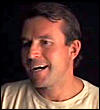

 Ed Viesturs' Quest for the 8,000 meter peaks |
 |
May 9, 2000 Interview Segments:
[Part I] [Part II]
MountainZone.com received a number of emails from people who said they were glad to see climbers making smart decisions. Does that surprise you?
No. I mean, even the public, the general public, is getting educated that climbing isn't always a do or die effort, that you don't have to kill yourself going up a mountain. You can fail because the mountain doesn't allow you to climb it. If you can use your experience and your training and your intelligence to evaluate what the situation is and say, 'for me, it's not worth the risks. I'm willing to walk away. Let's go look at a different possibility.' And it shows people, I think, that climbers aren't so stubborn that they can't think clearly and decide that something is not quite worth the risk all of the time.
"And it's always the journey, you know. It's not just the summit itself, but it's the whole process of going there, looking at the mountain, seeing if you can't climb it or not, and then if you can, you climb it, if you can't you go home, you know. So it is nice to hear that and see that and to see that people are understanding that and saying, 'hey, we understand that.' That's great.
What does your experience mean to somebody who wants to climb Annapurna? Do you know the mountain well enough to speculate on whether there are any safe routes?
I think the safest route would be the way that (Reinhold) Messner climbed it, which is kind of the Northwest Face. It's quite steep, it's quite technical, but there's not a lot of severe objective hazards. You just have to overcome the technical difficulties of climbing hard ice and steep rock at very high altitude. So, South Face, you know, that's technical too but I think there're a lot of hazards on the South Face also.
"So, if I go back, and if I decide to climb the mountain, it won't be by the North Face. I'll probably go and look at Messner's route on the northwest side, which may be the only safe option."
It was interesting that Neal was there because this was his first return to the Himalaya since that tragedy. And Michael is better known for his hard alpine climbs in Alaska.
"Well that's what he wanted. He wanted another chapter in his life to say, 'hey, look, I can move on from '96.' So he was loving it, totally, and Michael Kennedy, it was like his first 8000-meter expedition. He's got a hell of a career behind him but he'd never gone on a trip like this; and he's sitting at Base Camp, we're drinking coffee, and he's like, 'wow, I like this expedition stuff.' Because it's not always on-on-on-on-on-on when you're doing these hard alpine climbs, you're on for five or six days and you come down to Base Camp and then you relax and then you go back up. So he was diggin' it."
This was a little different than what you and Veikka usually do, Neal and Michael Kennedy were along with you, what was that like to be part of a group of friends?
"Yeah, I mean we still had a small group. Besides Veikka and myself, Neal Beidleman and Michael Kennedy joined us and you know, they've got tons of climbing experience and I'd known Neal for a number of years and didn't really know Michael but I'd bumped into him several times, and we really had a good time. It was fun to have four of us rather than two, there's more to talk about, more interaction.
"And both Neal and Michael are very solid climbers, very safe, very conservative and so we were always thinking along the same lines, every single day, every single decision, there was never any conflict. So it was great, it was a lot of fun. We still had a small group even though it was larger than the two of us."
What are your plans for 2001?
(![]() WATCH THE VIDEO)
WATCH THE VIDEO)
| STREAMING VIDEO Plans for 2001 | |
 | |
| REALPLAYER (28k) (56k) (100k) |
Can a climber really stay acclimated for a number of weeks?
"I know from my past experience that I've been able to stay acclimatized for five weeks. In '95 after we came off of Makalu, I came home, spent a couple of weeks here and by the time I got into Gasherbrum II it was five weeks later and we did a four-day ascent on Gasherbrum II, still using that acclimatization. So I think it's an individual thing. I don't think you could say 'yes' or 'no' for certain people or say it's going to last you two weeks or three weeks or six weeks; it's all kind of an individual thing. But I think for myself, five weeks is doable. So I have enough time after one peak if it's in a different country that I can come home, relax a little bit, spend time with the family and then go to another one and still do that one relatively fast.
—Peter Potterfield, MountainZone.com Staff
[Climbing Home] [MountainZone.com Home]